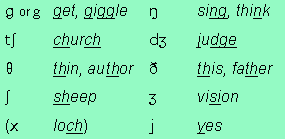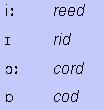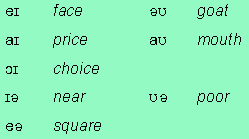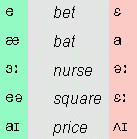IPA transcription systems for English
John Wells, University College London
1. Introduction: the IPA. 2.Pronunciations in dictionaries. 3. Consonants. 4. Stress. 5. Vowels: quantitative and qualitative. 6. Vowels: the standard scheme. 7. Upton's scheme.
In the text, non-ASCII/Latin1 phonetic symbols are shown as their SAMPA equivalents. If you have a Unicode font with IPA (such as Lucida Sans Unicode), there is also a Unicode version.
This article has now appeared in PG Bulletin, the bulletin of teachers of English phonetics in Chile and abroad, No. 9, 2001.
1. Introduction: the IPA
The International Phonetic Alphabet (IPA) is widely used for the transcription of English and many other languages. People are often surprised to find that not all authorities who claim to use the IPA transcribe the same words in the same way. They feel that since phonetics is a science there should be just one pronunciation scheme for a word.
The reasons for the fact that there are several such schemes can be summed up in the term academic freedom. No one can impose a given transcription scheme on an author, although most authors have the common sense to adopt a widely-used scheme rather than invent one of their own.
The IPA offers a set of symbols, and some general guidelines for their use. It does not prescribe transcription systems for particular languages. In practice, the system that people use may well depend on the purpose for which they use it. Specifying the pronunciation of a headword in a dictionary is one thing; transcribing a specimen of running speech, making notes in linguistic fieldwork, or annotating an acoustic display may each require something rather different. Transcriptions intended to be used by native speakers of a language may well differ from those intended for foreign learners; indeed, different groups of foreign learners may have rather different requirements.
The symbols currently recognized by the IPA are set out on the Chart of its Alphabet. There are over a hundred of them; any given language normally needs to exploit only a small subset.
2. Pronunciations in dictionaries
Our focus here is on British English dictionaries and how they indicate the pronunciation of each headword. First, a little history.
Until relatively recently, English dictionaries did not use IPA. Instead, they used (if anything) various respelling schemes. The only dictionaries that did use IPA were specialist pronunciation dictionaries, notably Daniel Jones's English Pronouncing Dictionary ("EPD", first edition 1917). The earliest general dictionaries to adopt IPA seem to have been dictionaries aimed at learners of English as a foreign language: the Oxford Advanced Learner's Dictionary (first edition 1948), the Longman Dictionary of Contemporary English (first edition, 1978). This was in response to market forces, since specialist teachers of pronunciation for EFL had been using IPA for many years. The first native-speaker dictionary with IPA may have been Collins English Dictionary (first edition 1979). Since then, many others have followed suit.
3. Consonants
The transcription of English consonants in IPA is not subject to any disagreement. Everyone agrees that we give the symbols /p, t, k, b, d, f, v, s, z, m, n, r, l, w, h/ their usual values as in ordinary spelling. The remainder are as shown in the box.

4. Stress
Likewise, there is no disagreement among IPA users about the symbols for word stress (although there may well be disagreement about the analysis of secondary stress). Primary stress is shown by the mark ', placed before the syllable concerned. (Compare the older, non-IPA, dictionary tradition, where it was shown by the mark ´ after the syllable.)
Secondary stress, if shown at all, is indicated by a similar mark below the line.
5. Vowels: quantitative and qualitative
 The pronunciation scheme used in the first twelve editions of EPD was one that required rather few special symbols. It achieved this parsimony by transcribing the English vowels quantitatively. This meant writing /i:/ for the vowel of reed and /i/ for that of rid, using the same phonetic symbol with and without a length mark. The vowel of cord was written /O:/, that of cod /O/, and similarly for other pairs. Thus the difference in vowel quality (vowel timbre, vowel colour) between such pairs of vowels was not shown explicitly but had to be inferred from the presence or absence of the length mark.
The pronunciation scheme used in the first twelve editions of EPD was one that required rather few special symbols. It achieved this parsimony by transcribing the English vowels quantitatively. This meant writing /i:/ for the vowel of reed and /i/ for that of rid, using the same phonetic symbol with and without a length mark. The vowel of cord was written /O:/, that of cod /O/, and similarly for other pairs. Thus the difference in vowel quality (vowel timbre, vowel colour) between such pairs of vowels was not shown explicitly but had to be inferred from the presence or absence of the length mark.
 Many phoneticians were dissatisfied with this scheme, feeling that the difference in vowel quality was at least as important as that of quantity. They preferred to use a scheme in which each vowel was shown by a separate letter-shape, without the use of length marks. Thus /i/ was used for reed, /I/ for rid, /O/ for cord and /Q/ for cod. This qualitative scheme was particularly popular among speech therapists and students of speech and drama.
Many phoneticians were dissatisfied with this scheme, feeling that the difference in vowel quality was at least as important as that of quantity. They preferred to use a scheme in which each vowel was shown by a separate letter-shape, without the use of length marks. Thus /i/ was used for reed, /I/ for rid, /O/ for cord and /Q/ for cod. This qualitative scheme was particularly popular among speech therapists and students of speech and drama.
 The rivalry of these two widely used schemes was resolved by A.C. Gimson. Both in his own works and in Jones's EPD, which he took over as editor, he made use of a scheme that was both qualititative and quantitative. It uses distinct letter-shapes for the different vowels, but also retains length marks for the long vowels. So reed is written with /i:/, rid with /I/, cord with /O:/, and cod with /Q/. The resulting scheme is admittedly somewhat redundant -- but almost all British phoneticians quickly rallied to it, and this quantitative-qualitative notation has become a de facto standard.
The rivalry of these two widely used schemes was resolved by A.C. Gimson. Both in his own works and in Jones's EPD, which he took over as editor, he made use of a scheme that was both qualititative and quantitative. It uses distinct letter-shapes for the different vowels, but also retains length marks for the long vowels. So reed is written with /i:/, rid with /I/, cord with /O:/, and cod with /Q/. The resulting scheme is admittedly somewhat redundant -- but almost all British phoneticians quickly rallied to it, and this quantitative-qualitative notation has become a de facto standard.
All three types of transcription can be defended as conforming to IPA principles. All are equally "scientific". All convey the same information, equally unambiguously. The difference is in what they make explicit and what they leave to be inferred. The quantitative-qualitative type, now generally adopted, makes explicit both vowel length and vowel quality.
6. Vowels: the standard scheme
By 1990 the quantitative-qualitative transcription had been adopted by all the most influential writers on phonetics in England, and by many general dictionaries. It is found, for example, in Collins English Dictionary, the Oxford Pocket Dictionary, and the Hutchinson Encyclopedic Dictionary, as well as in my own Longman Pronunciation Dictionary and in the 14th and 15th editions of Daniel Jones's English Pronouncing Dictionary, now edited by Peter Roach. It is what you will find in Gimson's Introduction to the Pronunciation of English and in the second edition of O'Connor's Better English Pronunciation. It is used in the Oxford Advanced Learner's Dictionary, the Longman Dictionary of Contemporary English, and the Collins Cobuild Dictionary. Almost all recent EFL textbooks published in Britain have adopted it.

 Here (left) is how the short vowels are represented in this scheme. To them we must add schwa (right), the weak vowel of ago, banana.
Here (left) is how the short vowels are represented in this scheme. To them we must add schwa (right), the weak vowel of ago, banana.
 To the right we see the symbols for the long vowels (monophthongs). Note that in every case not only is there a length mark, but the symbol shape is different from that for the corresponding short vowel.
To the right we see the symbols for the long vowels (monophthongs). Note that in every case not only is there a length mark, but the symbol shape is different from that for the corresponding short vowel.
 Lastly we have the diphthongs. These are vowels whose quality noticeably alters as the tongue moves in the course of their production. They are represented by two letters, one indicating the start of the diphthongal movement, the other indicating its end or general direction.
Lastly we have the diphthongs. These are vowels whose quality noticeably alters as the tongue moves in the course of their production. They are represented by two letters, one indicating the start of the diphthongal movement, the other indicating its end or general direction.
 There are also the sequences to be heard in words such as fire, power, which some people analyse as triphthongs: they are represented by the diphthong symbols as in price, mouth plus schwa. Some authors recognize other similar sequences as well (player, slower...), but there really seems to be no need to list them separately.
There are also the sequences to be heard in words such as fire, power, which some people analyse as triphthongs: they are represented by the diphthong symbols as in price, mouth plus schwa. Some authors recognize other similar sequences as well (player, slower...), but there really seems to be no need to list them separately.
English, like all languages, gradually changes over time. The transcription of some words has to change accordingly. Dictionaries still generally prescribe /U@/ for words such as poor, but it has to be admitted that more and more people pronounce /O:/ instead, making poor like pour, pore, paw; and similarly with other /U@/ words.
 Another recent trend is that of pronouncing the vowel at the end of happy, coffee, valley tense, like beat, rather than lax like bit. This is actually another weak vowel, restricted like schwa to unstressed syllables. Traditionally it was identified with the vowel of bit, and transcribed identically, /I/. However LDOCE decided instead to use the symbol /i/ (without length marks) for this vowel. This was intended as a kind of cover symbol, which everyone could interpret in their own way: traditionalists could think of it as identical with /I/, whereas users of the tenser vowel might want to identify it with /i:/. I followed this lead in my LPD and so subsequently did Roach in EPD-15 and Ashby in the Oxford ALD. (In fact we need two extra weak vowels: /i/ in happy and /u/ in situation.)
Another recent trend is that of pronouncing the vowel at the end of happy, coffee, valley tense, like beat, rather than lax like bit. This is actually another weak vowel, restricted like schwa to unstressed syllables. Traditionally it was identified with the vowel of bit, and transcribed identically, /I/. However LDOCE decided instead to use the symbol /i/ (without length marks) for this vowel. This was intended as a kind of cover symbol, which everyone could interpret in their own way: traditionalists could think of it as identical with /I/, whereas users of the tenser vowel might want to identify it with /i:/. I followed this lead in my LPD and so subsequently did Roach in EPD-15 and Ashby in the Oxford ALD. (In fact we need two extra weak vowels: /i/ in happy and /u/ in situation.)
It is fair to say that by the 90's, with these minor tweakings, the Gimson quantitative-qualitative scheme had become the standard IPA transcription system for RP-oriented phonetics.
7. Upton's scheme
 This hard-won uniformity was shaken, however, by Clive Upton's appointment as pronunciation consultant for Oxford's native-speaker dictionaries. His scheme, adopted by the influential Concise Oxford Dictionary (1995) remains quantitative-qualitative, but differs from the standard scheme in the symbolization of five vowels (see box: the standard notation in green, Upton's in pink). In at least some of the cases one can see what motivated Upton to alter the standard symbol: but in my view the supposed gains did not make up for the sacrifice of an agreed standard.
This hard-won uniformity was shaken, however, by Clive Upton's appointment as pronunciation consultant for Oxford's native-speaker dictionaries. His scheme, adopted by the influential Concise Oxford Dictionary (1995) remains quantitative-qualitative, but differs from the standard scheme in the symbolization of five vowels (see box: the standard notation in green, Upton's in pink). In at least some of the cases one can see what motivated Upton to alter the standard symbol: but in my view the supposed gains did not make up for the sacrifice of an agreed standard.
Upton's reforms: for and against
- Bet. In some languages, notably French and German, one needs to distinguish two e-type vowels, a closer one (IPA [e]) and an opener one (IPA [E]). The English bet vowel lies between them, but is more similar to [E], which is why Upton prefers that symbol. However, from the point of view of an EFL learner whose native language is, say, Japanese or Greek -- languages that have no such distinction -- it is quite unnecessary to distinguish the "[e]" at the starting point of the face diphthong and the "[E]" of bet.
- Bat. It is well known that the quality of the RP bat vowel has changed since the 1930's. It is now more similar to "cardinal [a]" than it used to be. Hence Upton's choice of the [a] symbol. A more conservative line is to stick with the familiar symbol [æ], but to redefine it as appropriate. That, after all, is what we have all done with the [V] symbol for the vowel of cut, blood, which used to be a back vowel but now has a central/front quality for which the most specific IPA symbol would probably be [6] (turned a). A further argument in favour of retaining the symbol [æ] is that it preserves the parallelism with American and Australian English, in which the movement towards an opener quality has not taken place.
- Nurse. For many speakers there is no appreciable difference in quality between the short [@] in ago and the long vowel of nurse. Hence Upton writes them with the same symbol, with and without length marks. The arguments against this are that (i) all other long-short pairs use distinct letter shapes alongside presence/absence of length marks; (ii) schwa is a weak vowel, restricted to unstressed syllables, and subject to very considerable variability depending on its position. This is not true of the nurse vowel. (I concede that the logic of this argument would lead also to the avoidance of the schwa symbol in the goat diphthong [@U]. It might well have been better if Gimson had chosen to write this diphthong as [3U]. I was tempted to innovate in LPD by using that symbol. But I decided, rightly I believe, that it was not worth upsetting an agreed standard for.)
- Square. People do increasingly use a long monophthong for this vowel, rather than the schwa-tending diphthong implied by the standard symbol. What used to be a local-accent feature has become part of the mainstream. There are millions of English people, however, who still use a diphthong. To produce the distinction in pairs such as shed -- shared EFL learners generally find it easier to make the square vowel diphthongal ([e@]) rather than depend on length alone.
- Price. The standard notation might seem to imply that the starting point of the price diphthong is the same as that of the mouth diphthong. In practice, speakers vary widely in how the two qualities compare. In mouth people in the southeast of England typically have a rather bat-like starting point, while in price their starting point is more like cart. In traditional RP the starting points are much the same. Upton's notation implicitly identifies the first element of price with the vowel quality of cut -- an identification that accords with the habits neither of RP nor of southeastern speech (Estuary English), and strikes me as bizarre.